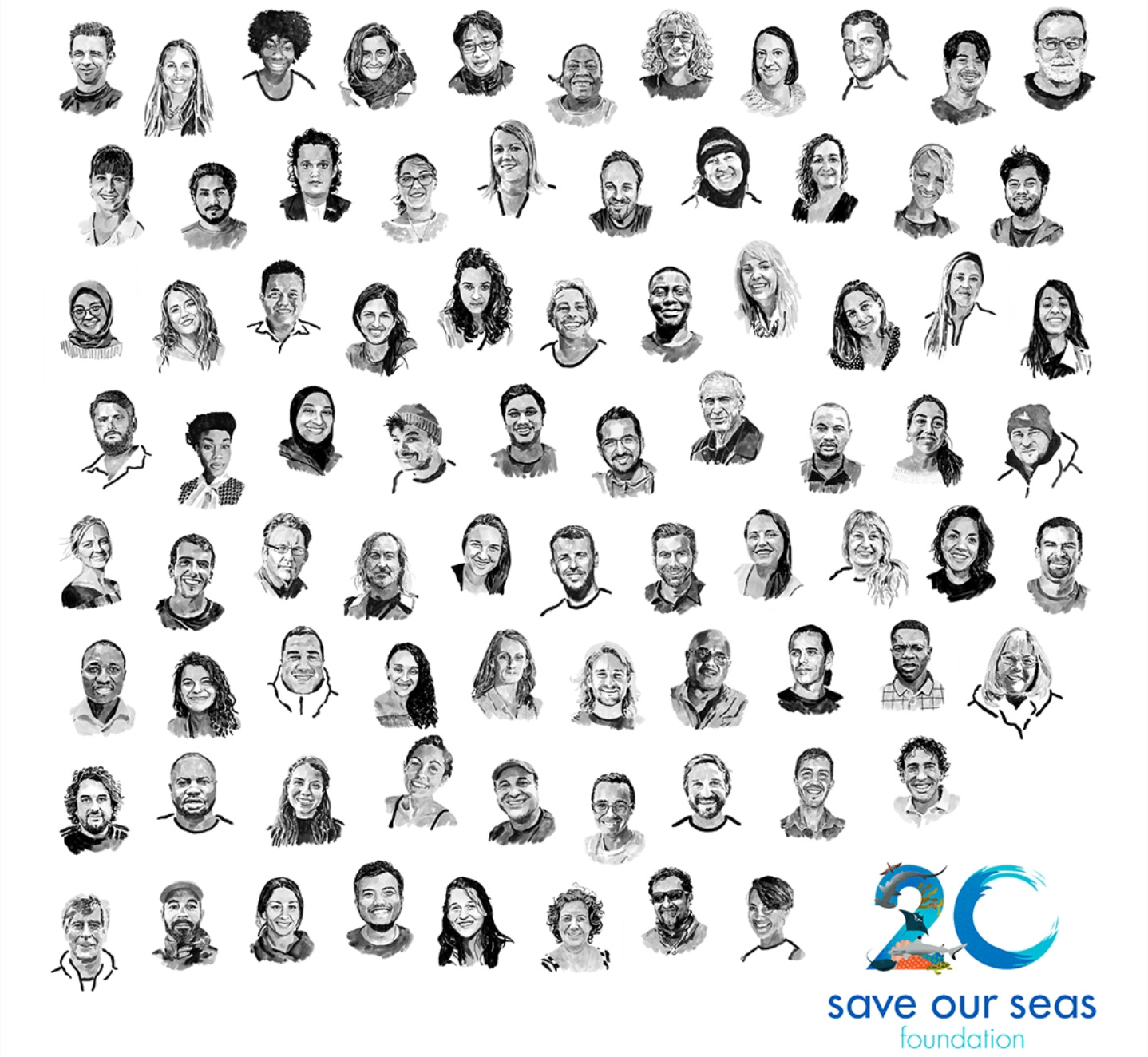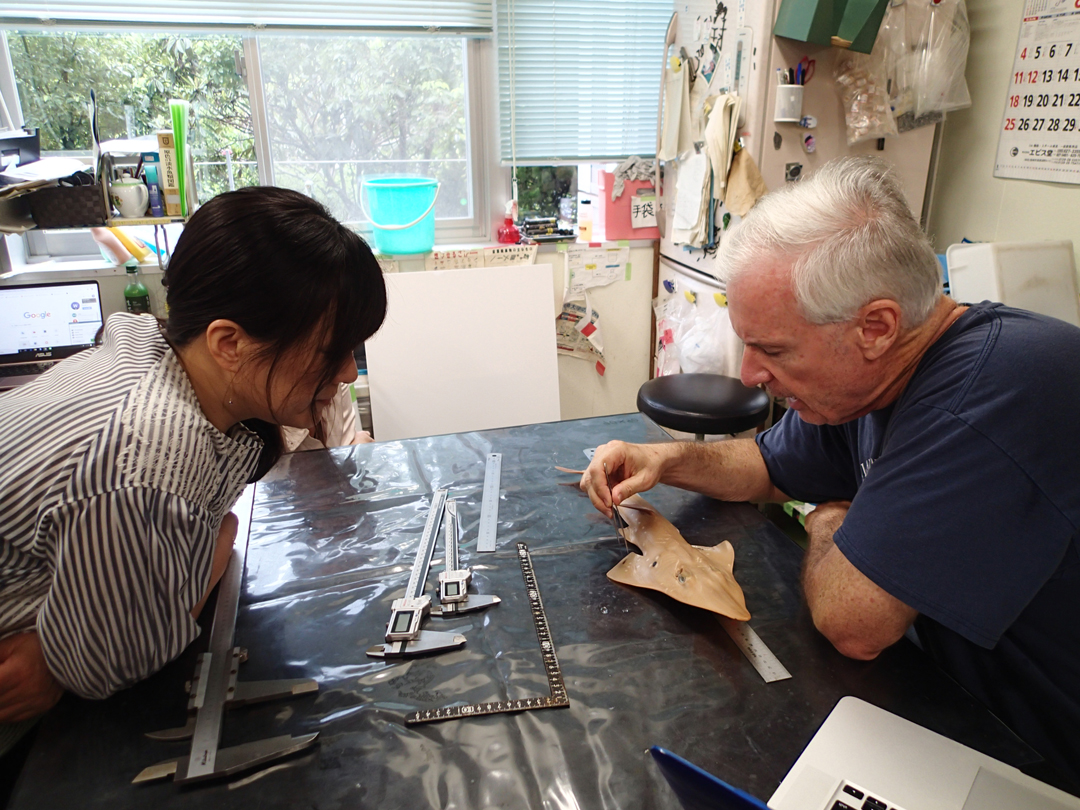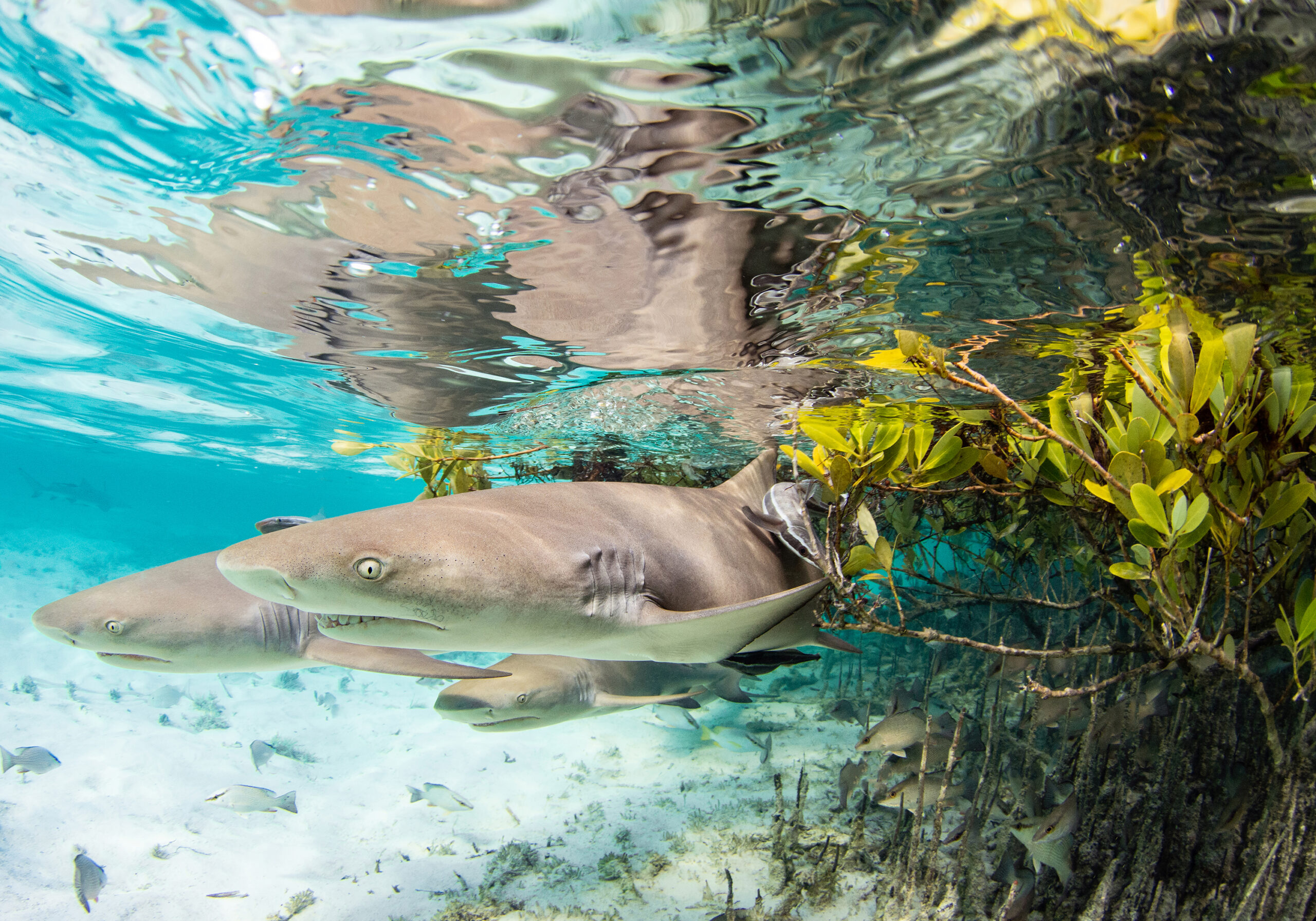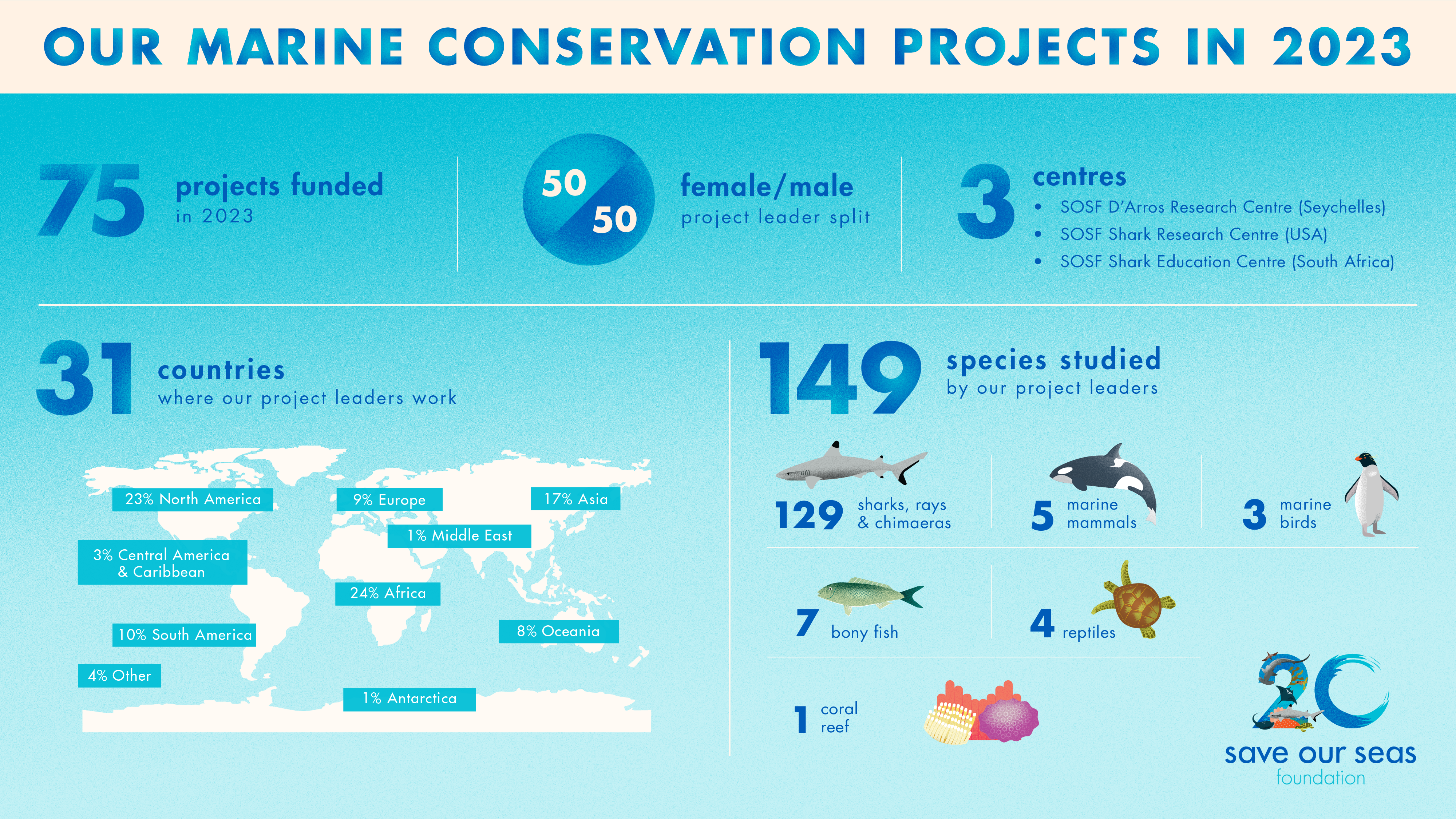2023 Keystone grants
To commemorate our 20th anniversary and the milestone this means for shark and ray research, conservation and education, this year we are also boasting our largest number of keystone grants to date! With 29 new keystone projects, 18 continuation keystone projects, we are funding an impressive 47 keystone projects this year!
In an effort to protect life in our oceans, especially sharks and rays, we have expanded our support of global marine research, conservation and education initiatives. Our robust Keystone Grants, which run for up to three years, are a great example of this in action; aimed at generating critical knowledge on marine species and their habitats.

Our project leaders for 2023. Profile sketches by Sam Kerr
Macquarie Harbour in Tasmania is the last stronghold of the Endangered Maugean skate, the only chondrichthyan on Australia’s list of top 100 priority conservation species. Cynthia has been monitoring the skate’s population since 2014 and has observed its decline and a lack of new juveniles.
Kim and Atlantine are filling in the missing information for one of the five Endangered devil ray species that call the Atlantic Ocean home. The pygmy devil ray is declining throughout its range, but little is known about its biology and ecology that can help conserve it.
Ramón is combining modern (environmental DNA, BRUVs and UAVs) and traditional methods to search for sharks and rays in two coastal nursery areas in Mexico. He wants to find essential shark areas on the Mexican Caribbean coast that can feed into the IUCN’s Important Shark and Rays Areas (ISRAs) process, putting key habitats on the map with the information needed to protect them.
Potentially one of the few remaining strongholds of the largetooth sawfish, the sandbanks, mangroves and murky waters along the coastline influenced by the Amazon River are where Patricia and Vincente are searching for this Critically Endangered species.
Danny believes in the power of storytelling to shine a light on angel sharks, to start conversations, unlock historical knowledge archived in the coastal communities of the Mediterranean and East Atlantic region and even impact management decisions. He wants to contribute to the conservation of the three angel shark species (of 23 species globally) that are found in the Mediterranean and East Atlantic by telling their story and that of those working to protect them.
With more than a third of sharks and rays threatened with extinction, and three sharks possibly already extinct, we’re in a race to document and protect many species before they’re gone. Dave’s interest lies in the details: while many charismatic species might be protected, there are a great many more ‘lost sharks’ that we know almost nothing about and they may disappear before we even recognise them.

Principle investigator Dave examining a small Smoothnose Wedgefish with Dr. Atsuko Yamaguchi in her lab at the University of Nagasaki. Photo © Atsuko Yamaguchi
Brittany is using a combination of methods to understand the vulnerability of gulper sharks to longline fisheries in New Zealand’s South Pacific Ocean. She will be satellite-tagging gulper sharks and looking at post-release mortality (how likely are gulper sharks to survive being caught and released in fisheries?).
Outside the USA, The Bahamas is the only place where Critically Endangered smalltooth sawfish can reliably be found. Tristan wants to ensure that protection measures in The Bahamas are understood and enforced as far as sawfish are concerned to close the current gap between policy and the people.
Jens is unlocking information about how and where largetooth sawfish spend their lives through the chemistry of their teeth. The long, toothed rostrum for which sawfish are named might hold some answers about where a sawfish grew up, where it moved, how fast it grew during each period of life, and how its place in the food web changed as it grew.
Steven and Kevin are using genetic techniques to understand how Caribbean reef shark populations are connected across the extent of their range. Populations of this Endangered shark are in decline generally, but where they are managed and there is effective protection, their numbers are stable.
John is looking at the histories that are laid down in the cartilage of shark skeletons throughout their lives, exploring chemical tagging as an alternative means of understanding the details of sharks’ life histories. While we use acoustic, satellite and physical tagging to understand how sharks move and what they do, natural chemical tagging might provide a complementary or alternative method that overcomes some challenges.

Photo © Jillian Morris
Jillian is catalysing a community-driven shark conservation programme in Turks and Caicos. She is combining research and outreach to engage young locals in the conservation of sharks and their mangrove habitats. To understand the habitat use and movement patterns of young lemon sharks, Jillian will train local young adults to assist with the shark-tagging programme.
Questions of how climate change, human disturbances and habitat alterations might affect how reef manta rays use their coral reef homes can only be answered if we understand the intricacies of how they live now. Rachel is looking to answer those questions using novel biologging technology, devising methods of attaching the devices safely onto wild reef mantas and then tracking the animals’ time-energy budgets.
In a world where mitigating climate change is critical, the US development of offshore wind energy infrastructure along its coastline could be an important step. But what are its consequences? Kyle wants to know how the wind energy infrastructure will affect these super senses and impact the sharks’ and rays’ movements, distribution and choice of remaining coastal habitats.
With very little information available about Endangered sicklefin devil rays, their seasonal aggregations at sea mounts in the Azores give Sophie an opportunity to learn more about their lives. She will be collecting satellite-tracking data that show how they move in the Azores’ exclusive economic zone.
In the Azores, slow-moving whale sharks are often found feeding on frenzied bait fish in association with tuna. Fishers in the Azores also prefer to target these large schools of tuna, putting them in competition with the whale sharks. Using a combination of historical and biologging data, Jorge hopes to understand more about these whale shark and tuna associations and to better inform the conservation measures needed to protect them.

A whale shark swims through a school of fish in Azores. Photo © Sebastian Staines
Alice is asking critical questions about how a changing climate and more frequent extreme weather events are going to affect sevengill sharks in Fiordland, New Zealand. Will their movement patterns differ? Might they escape to deeper waters to avoid heat stress in the shallows? Does their behaviour change in the short term, when floods hit or droughts strike?
With the increasing incidence of illegal fishing along the East African coast, Cyrus is determined to turn the tide for threatened mobulid ray species. He will engage with local communities and build capacity for them to identify and protect these threatened rays. He ultimately hopes to improve law enforcement, especially where they are still exploited in local markets due to the low capacity of enforcement officials to identify which species are being traded.
With nets that scrape the sea floor, demersal trawling can have a hugely detrimental impact on threatened guitarfish populations. Ismet is on a mission to discover hotspots in the eastern Mediterranean where guitarfish can be protected from trawling: areas that can be closed or where seasonal closures can protect these rays during their most vulnerable stages.
Issah is gathering as much information as he can about sharks and rays along Ghana’s coast. He hopes to build capacity for 10 local volunteers to support the long-term collection of shark and ray data in the country, and will pilot alternative livelihood options with fishers.
There are still many questions about the Critically Endangered ray that frequents South Africa’s coastline. Foremost among them: is this the common eagle ray, or is it something previously undescribed? Michelle is using a combination of techniques to find out whether the eagle rays of the north-eastern Atlantic Ocean are the same species as those in South Africa.
Knowing how big predators feed is key to managing their populations properly. But sampling where sharks fit into the food web can often be logistically challenging, financially limiting and sometimes invasive. Brett is exploring a technique called dried blood spot sampling as a novel, minimally invasive method to discover how sharks forage.
John is developing new ways to count endangered whitespotted eagle rays in the eastern Gulf of Mexico. Called close-kin mark-recapture, the method combines the latest in genomics and statistics to assess shark and ray populations. Once refined, it may allow us to understand the scale of whitespotted eagle ray population declines.
Kevin and Wei-Chuan know that information about the critical habitats used by highly endangered wedgefish and guitarfish species is needed in order to protect them. In Taiwan, in spite of these animals’ vulnerable conservation status, fisheries still catch them unintentionally and are legally allowed to retain them. This can be changed, but only with the right information.

Artwork by Jamy Silver | © Save Our Seas Foundation
Keystone continuations
Yolarnie is working to provide information to bolster fisheries management of the Endangered winghead shark in the Kikori Delta of Papua New Guinea.
Tom Hart wants to know whether rising sea temperatures, increasing krill fishing or a growing tourism presence is driving declines of Antarctic Peninsula penguins.
Building a generation of critical thinkers and fostering a sense of connection are what Anshena’s work at the Cape Eleuthera Island School in The Bahamas is all about.
Aristide Takoukam Kamla created a citizen science platform and mobile app for fishermen across Cameroon’s 400 km coastline to record sightings of sharks, rays, and marine life. These photos are uploaded to iNaturalist where they are identified and will serve to create Cameroon’s first elasmobranch atlas.
Pelayo Salinas is on a mission to keep the Galapagos, in his words: ‘the sharkiest place on the planet’. Leveraging what he’s learned from baseline surveys, and collaboration with Professor Mahmood Shivji at the Save our Seas Shark Research Centre (SOS-SRC), his research is now assessing the migratory routes and population genetics of pregnant scalloped hammerhead sharks across the Tropical Eastern Pacific.
Hollie Booth is investigating how marine tourism can contribute to conservation in the global diving treasure that is Indonesia. Nestled in the heart of the ‘Coral Triangle’, Indonesia is an archipelago of contrasts: it is both a global biodiversity hotspot, and the world’s largest shark fishing nation.
Working with fishing communities and conservation partners along the North Coast of the Java Sea in Indonesia, Een Putra aims to raise awareness and garner support for the conservation of the Critically Endangered rhinoray found in the region.
Peter Kyne credits the recent location of the rare and relatively unknown clownfish wedgefish to social media posts of wedgefish catches. But his focus now is ground-truthing where this species occurs in the wild, and which habitat it uses. For this, he’s engaging with local fishers around the Riau Islands in Indonesia.
Andrew Chin’s team is scouring rivers, local fish markets and landing sites to increase scientific attention on the threatened river sharks and rays of Borneo.
Nadia Rubio learns about marine life from those who spend their life around the sea. She collects local ecological knowledge (LEK) about sharks, sawfishes, manatees and sea turtles, and connects this information with spatial data to understand Mexico’s marine biodiversity.
Nigel Downing is forging ahead with what he hopes may become a 23-year-long survey of the recovery of Seychelles’ southernmost reefs. In 1999, he established the Aldabra Marine Programme (AMP) and studied the reefs until 2008, tracking their recovery after a strong coral bleaching event in 1998. Now, after a 13-year-long hiatus, he is covering survey sites between four key islands and reef systems: Aldabra, Assumption, Astove and St Pierre.
Jeremy Kiszka wants to understand when blue whales and other whales and dolphins visit Seychelles, and how many visits when they do
Craig Foster and Jannes Landschoff are diving into the Great African Seaforest in South Africa to bring to shore 1001 stories of the species that live there. Combining marine biological research with the art of underwater tracking, nature documentary-making and storytelling, the pair from the Sea Change Project hope to build a biodiversity dataset from the region that will grow and ultimately nurture a new appreciation for the fragility and wonder of nature.
Kelly Kingon is hoping to identify areas that baby hammerhead sharks prefer and possibly use as nurseries so that she can help develop management plans to protect these havens.
Catherine Jones is intent on helping better monitor flapper skates and spurdogs in the North-East Atlantic. She and her team are identifying a subset of the most informative genetic markers for each species, which will help inform conservation strategies and MPA management for both species in Scottish seas.
Jasmin Graham and her team create content to teach the general public about elasmobranchs (sharks, skates and rays), the threats they face and current conservation efforts to protect them.
Lee Crockett is the Executive Director of the Shark Conservation Fund (SCF), who distribute grants, aiming to end the global overexploitation of sharks and rays. Using sharks and rays as flagship species, the fund’s mission is to protect the health of the oceans by maintaining their function.
The beaches of D’Arros Island and St Joseph Atoll are very important places for mother sea turtles to come and lay their eggs. Jeanne Mortimer is training Seychellois monitors to observe nesting turtles and collect data about them.
Terence Vel has been running the Wildlife Clubs of Seychelles and working with the Unisey Centre for Environment and Education (UCEE) for many years. He is a long-standing grant recipient from the Foundation. His work has been to make the wonders of the natural world, and the incredible heritage of Seychelles, available to children and young adults.
